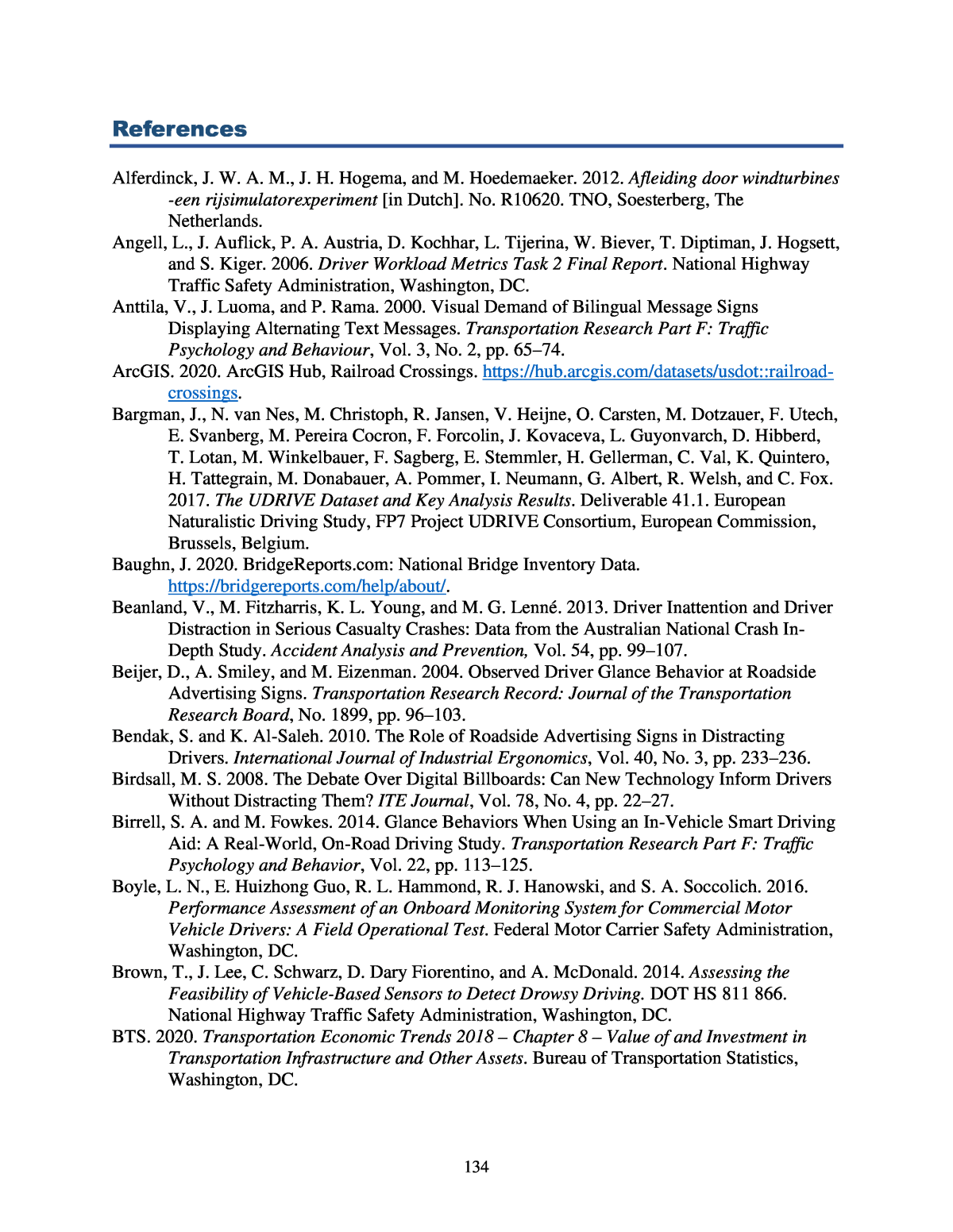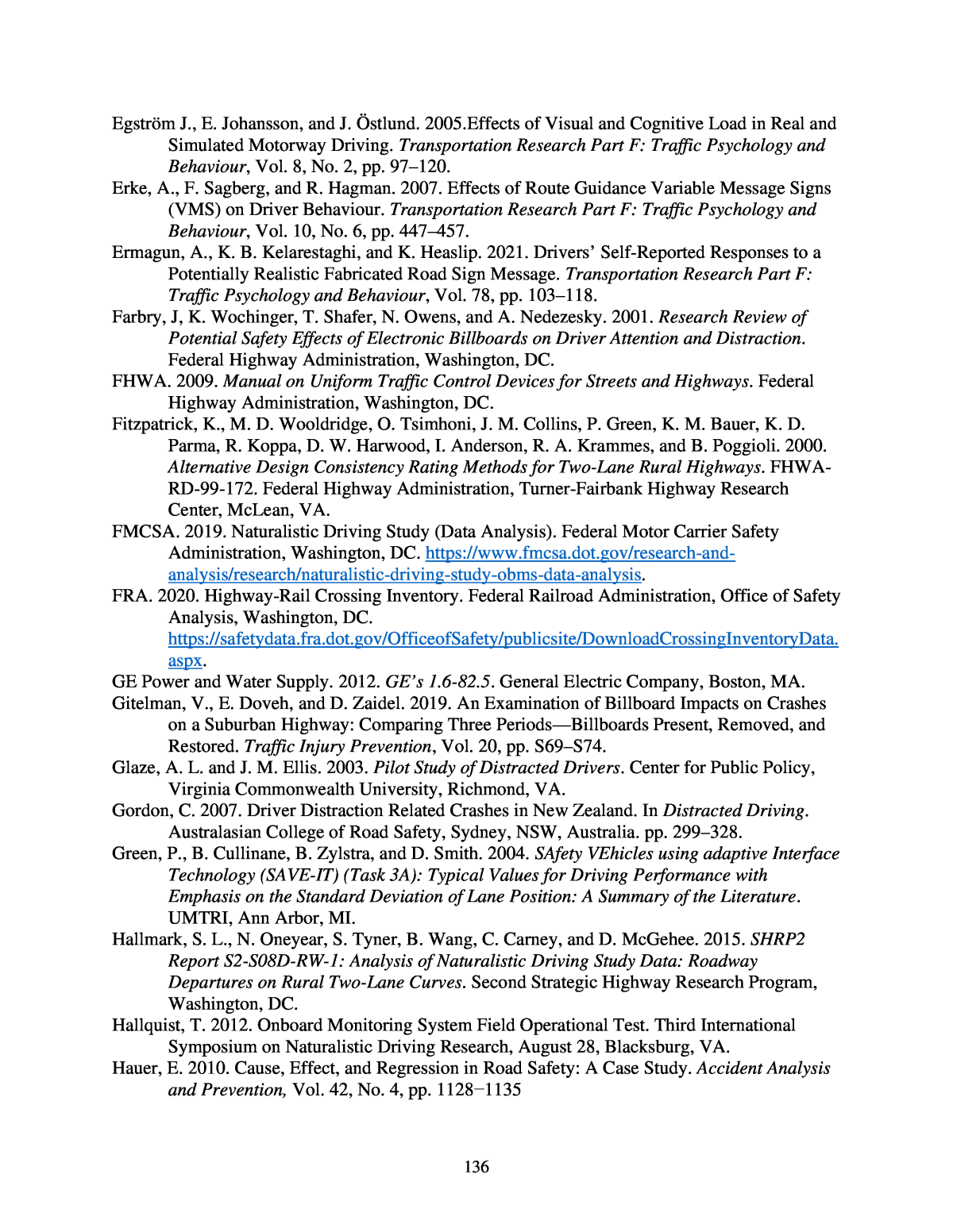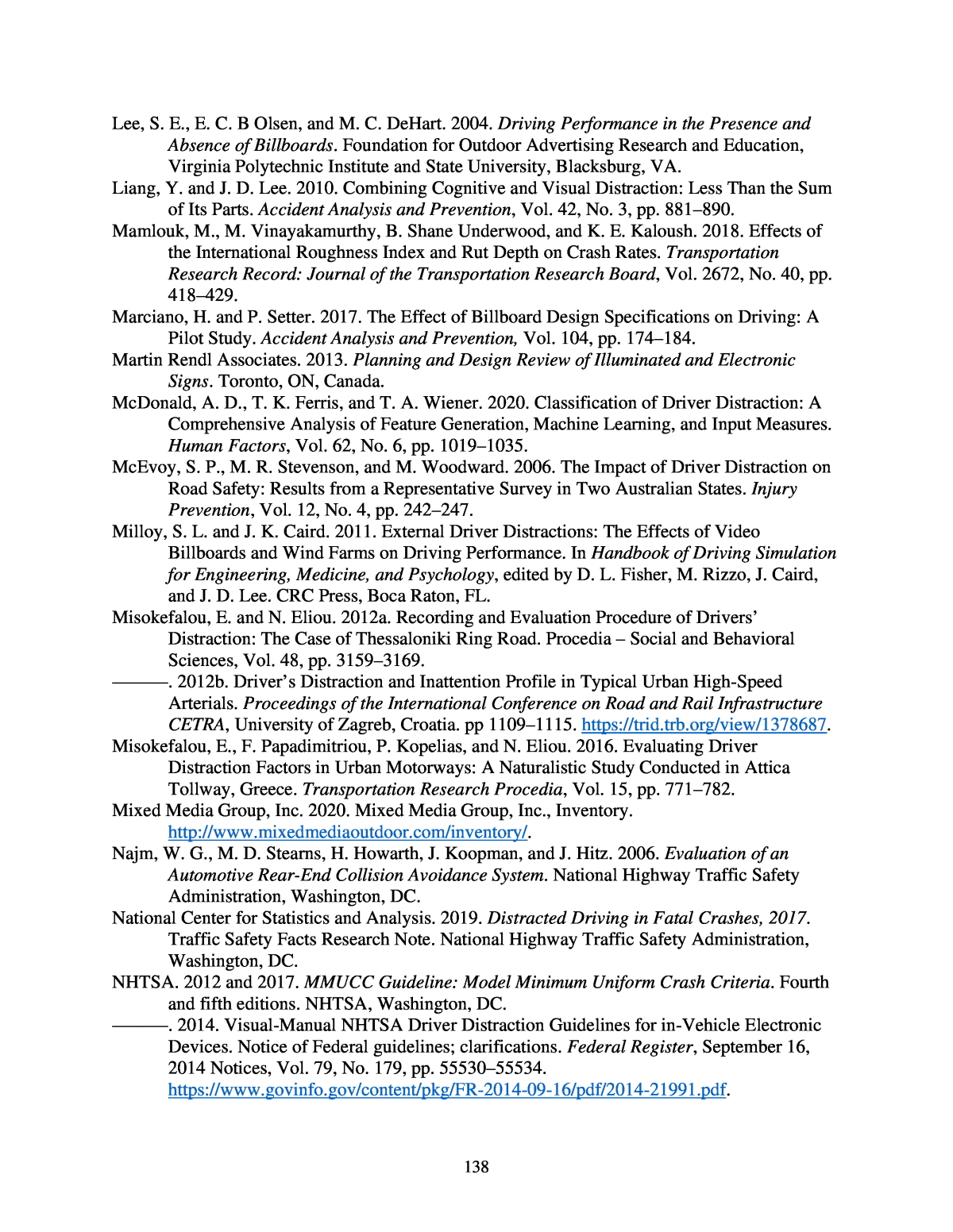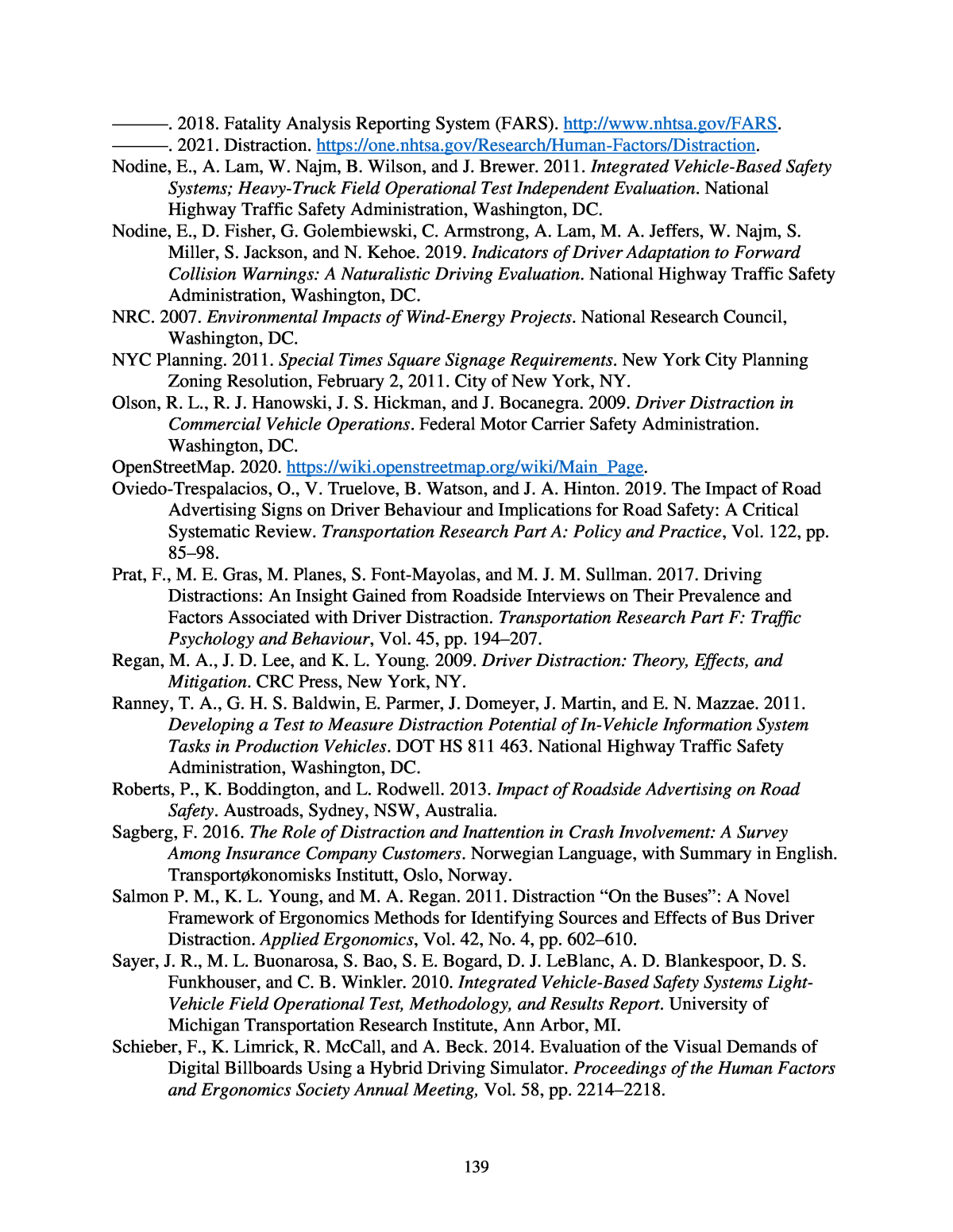







Below is the uncorrected machine-read text of this chapter, intended to provide our own search engines and external engines with highly rich, chapter-representative searchable text of each book. Because it is UNCORRECTED material, please consider the following text as a useful but insufficient proxy for the authoritative book pages.
134 References Alferdinck, J. W. A. M., J. H. Hogema, and M. Hoedemaeker. 2012. Afleiding door windturbines -een rijsimulatorexperiment [in Dutch]. No. R10620. TNO, Soesterberg, The Netherlands. Angell, L., J. Auflick, P. A. Austria, D. Kochhar, L. Tijerina, W. Biever, T. Diptiman, J. Hogsett, and S. Kiger. 2006. Driver Workload Metrics Task 2 Final Report. National Highway Traffic Safety Administration, Washington, DC. Anttila, V., J. Luoma, and P. Rama. 2000. Visual Demand of Bilingual Message Signs Displaying Alternating Text Messages. Transportation Research Part F: Traffic Psychology and Behaviour, Vol. 3, No. 2, pp. 65â74. ArcGIS. 2020. ArcGIS Hub, Railroad Crossings. https://hub.arcgis.com/datasets/usdot::railroad- crossings. Bargman, J., N. van Nes, M. Christoph, R. Jansen, V. Heijne, O. Carsten, M. Dotzauer, F. Utech, E. Svanberg, M. Pereira Cocron, F. Forcolin, J. Kovaceva, L. Guyonvarch, D. Hibberd, T. Lotan, M. Winkelbauer, F. Sagberg, E. Stemmler, H. Gellerman, C. Val, K. Quintero, H. Tattegrain, M. Donabauer, A. Pommer, I. Neumann, G. Albert, R. Welsh, and C. Fox. 2017. The UDRIVE Dataset and Key Analysis Results. Deliverable 41.1. European Naturalistic Driving Study, FP7 Project UDRIVE Consortium, European Commission, Brussels, Belgium. Baughn, J. 2020. BridgeReports.com: National Bridge Inventory Data. https://bridgereports.com/help/about/. Beanland, V., M. Fitzharris, K. L. Young, and M. G. Lenné. 2013. Driver Inattention and Driver Distraction in Serious Casualty Crashes: Data from the Australian National Crash In- Depth Study. Accident Analysis and Prevention, Vol. 54, pp. 99â107. Beijer, D., A. Smiley, and M. Eizenman. 2004. Observed Driver Glance Behavior at Roadside Advertising Signs. Transportation Research Record: Journal of the Transportation Research Board, No. 1899, pp. 96â103. Bendak, S. and K. Al-Saleh. 2010. The Role of Roadside Advertising Signs in Distracting Drivers. International Journal of Industrial Ergonomics, Vol. 40, No. 3, pp. 233â236. Birdsall, M. S. 2008. The Debate Over Digital Billboards: Can New Technology Inform Drivers Without Distracting Them? ITE Journal, Vol. 78, No. 4, pp. 22â27. Birrell, S. A. and M. Fowkes. 2014. Glance Behaviors When Using an In-Vehicle Smart Driving Aid: A Real-World, On-Road Driving Study. Transportation Research Part F: Traffic Psychology and Behavior, Vol. 22, pp. 113â125. Boyle, L. N., E. Huizhong Guo, R. L. Hammond, R. J. Hanowski, and S. A. Soccolich. 2016. Performance Assessment of an Onboard Monitoring System for Commercial Motor Vehicle Drivers: A Field Operational Test. Federal Motor Carrier Safety Administration, Washington, DC. Brown, T., J. Lee, C. Schwarz, D. Dary Fiorentino, and A. McDonald. 2014. Assessing the Feasibility of Vehicle-Based Sensors to Detect Drowsy Driving. DOT HS 811 866. National Highway Traffic Safety Administration, Washington, DC. BTS. 2020. Transportation Economic Trends 2018 â Chapter 8 â Value of and Investment in Transportation Infrastructure and Other Assets. Bureau of Transportation Statistics, Washington, DC.
135 Campbell, J. L., J. L. Brown, J. S. Graving, C. M. Richard, M. G. Lichty, T. Sanquist, L. Paige Bacon, R. Woods, H. Li, D. N. Williams, and J. L. Morgan. 2016. Human Factors Design Guidance for Driver-Vehicle Interfaces. DOT HS 812 360. National Highway Traffic Safety Administration, Washington, DC. Chapman, S. and F. Crichton. 2017. Wind Turbine Syndrome: A Communicated Disease. Sydney University Press, Sydney, NSW, Australia. Costa, M., A. Simone, V. Vignali, C. Lantieri, A. Bucchi, and G. Dondi. 2014. Looking Behavior for Vertical Road Signs. Transportation Research Part F: Traffic Psychology and Behaviour, Vol. 23, pp. 147â155. Costa, M., L. Bonetti, V. Vignali, A. Bichicchi, C. Lantieri, and A. Simone. 2019. Driverâs Visual Attention to Different Categories of Roadside Advertising Signs. Applied Ergonomics, Vol. 78, pp.127â136. CTC & Associates. 2012. Effects of Outdoor Advertising Displays on Driver Safety. California Department of Transportation â Division of Research and Innovation, Sacramento, CA. De Ceunynck, T., E. De Pauw, S. Daniels, E. Polders, T. Brijs, E. Hermans, and G. Wets. 2017. The Effect of Wind Turbines Alongside Motorways on Driversâ Behaviour. European Journal of Transport and Infrastructure Research, Vol. 17, No. 4, pp. 477â494. Decker, J. S., S. J. Stannard, B. McManus, S. M. O. Wittig, V. P. Sisiopiku, and D. Stavrinos. 2015. The Impact of Billboards on Driver Visual Behavior: A Systematic Literature Review. Traffic Injury Prevention, Vol. 16, pp. 234â239. Dewar, R. E. and P. L. Olson. 2007. Human Factors in Traffic Safety. 2nd Edition. Lawyers and Judges Publishing Company, Inc., Tucson, AZ. Dingus, T. A., J. M. Hankey, J. F. Antin, S. E. Lee, L. Eichelberger, K. Stulce, D. McGraw, M. Perez, and L. Stowe. 2014. SHRP 2 Report S2-S06-RW-1: Naturalistic Driving Study: Technical Coordination and Quality Control. Second Strategic Highway Research Program, Washington, DC. Dingus, T. A., F. Guo, S. E. Lee, J. F. Antin, M. Perez, M. Buchanan-King, and J. M. Hankey. 2016. Driver Crash Risk Factors and Prevalence Evaluation Using Naturalistic Driving Data. Proceedings of the National Academy of Sciences, Vol. 113, No. 10, pp. 2636â 2641. Domke, K., K. Wandachowicz, M. Zalesinska, S. Mroczkowska, and P. Skrzypczak. 2011. Digital Billboards and Road Safety. First International Conference on Lighting in Engineering, Architecture and the Environment. WIT Transactions on the Built Environment, Vol. 121, pp. 119â131. Dukic, T., C. Ahlstrom, C. Patten, C. Kettwich, and K. Kircher. 2013. Effects of Electronic Billboards on Driver Distraction. Traffic Injury Prevention, Vol. 14, No. 5, pp. 469â476. Easa, S. M. and W. He. 2006. Modeling Driver Visual Demand on Three-Dimensional Highway Alignments. Journal of Transportation Engineering, Vol. 132, No. 5, pp. 357â365. Edquist, J., T. Horberry, M. Regan, and I. R Johnston. 2007. âVisual Clutterâ and External-to- Vehicle Driver Distraction. In Distracted Driving, edited by I. J. Faulks, M. Regan, M. Stevenson, J. Brown, A. Porter, and J. D. Irwin. Australasian College of Road Safety, Sydney, NSW, Australia, pp. 413â432. Edquist, J, T. Horberry, S. Hosking, and I. Johnston. 2011. Effects of Advertising Billboards During Simulated Driving. Applied Ergonomics, Vol. 42, No. 4, pp. 619â626.
136 Egström J., E. Johansson, and J. Ãstlund. 2005.Effects of Visual and Cognitive Load in Real and Simulated Motorway Driving. Transportation Research Part F: Traffic Psychology and Behaviour, Vol. 8, No. 2, pp. 97â120. Erke, A., F. Sagberg, and R. Hagman. 2007. Effects of Route Guidance Variable Message Signs (VMS) on Driver Behaviour. Transportation Research Part F: Traffic Psychology and Behaviour, Vol. 10, No. 6, pp. 447â457. Ermagun, A., K. B. Kelarestaghi, and K. Heaslip. 2021. Driversâ Self-Reported Responses to a Potentially Realistic Fabricated Road Sign Message. Transportation Research Part F: Traffic Psychology and Behaviour, Vol. 78, pp. 103â118. Farbry, J, K. Wochinger, T. Shafer, N. Owens, and A. Nedezesky. 2001. Research Review of Potential Safety Effects of Electronic Billboards on Driver Attention and Distraction. Federal Highway Administration, Washington, DC. FHWA. 2009. Manual on Uniform Traffic Control Devices for Streets and Highways. Federal Highway Administration, Washington, DC. Fitzpatrick, K., M. D. Wooldridge, O. Tsimhoni, J. M. Collins, P. Green, K. M. Bauer, K. D. Parma, R. Koppa, D. W. Harwood, I. Anderson, R. A. Krammes, and B. Poggioli. 2000. Alternative Design Consistency Rating Methods for Two-Lane Rural Highways. FHWA- RD-99-172. Federal Highway Administration, Turner-Fairbank Highway Research Center, McLean, VA. FMCSA. 2019. Naturalistic Driving Study (Data Analysis). Federal Motor Carrier Safety Administration, Washington, DC. https://www.fmcsa.dot.gov/research-and- analysis/research/naturalistic-driving-study-obms-data-analysis. FRA. 2020. Highway-Rail Crossing Inventory. Federal Railroad Administration, Office of Safety Analysis, Washington, DC. https://safetydata.fra.dot.gov/OfficeofSafety/publicsite/DownloadCrossingInventoryData. aspx. GE Power and Water Supply. 2012. GEâs 1.6-82.5. General Electric Company, Boston, MA. Gitelman, V., E. Doveh, and D. Zaidel. 2019. An Examination of Billboard Impacts on Crashes on a Suburban Highway: Comparing Three PeriodsâBillboards Present, Removed, and Restored. Traffic Injury Prevention, Vol. 20, pp. S69âS74. Glaze, A. L. and J. M. Ellis. 2003. Pilot Study of Distracted Drivers. Center for Public Policy, Virginia Commonwealth University, Richmond, VA. Gordon, C. 2007. Driver Distraction Related Crashes in New Zealand. In Distracted Driving. Australasian College of Road Safety, Sydney, NSW, Australia. pp. 299â328. Green, P., B. Cullinane, B. Zylstra, and D. Smith. 2004. SAfety VEhicles using adaptive Interface Technology (SAVE-IT) (Task 3A): Typical Values for Driving Performance with Emphasis on the Standard Deviation of Lane Position: A Summary of the Literature. UMTRI, Ann Arbor, MI. Hallmark, S. L., N. Oneyear, S. Tyner, B. Wang, C. Carney, and D. McGehee. 2015. SHRP2 Report S2-S08D-RW-1: Analysis of Naturalistic Driving Study Data: Roadway Departures on Rural Two-Lane Curves. Second Strategic Highway Research Program, Washington, DC. Hallquist, T. 2012. Onboard Monitoring System Field Operational Test. Third International Symposium on Naturalistic Driving Research, August 28, Blacksburg, VA. Hauer, E. 2010. Cause, Effect, and Regression in Road Safety: A Case Study. Accident Analysis and Prevention, Vol. 42, No. 4, pp. 1128â1135
137 Herrstedt, L., P. Greibe, and P. K. Andersson. 2013. Driver Attention is Captured by Roadside Advertising Signs. Sixteenth International Conference Road Safety on Four Continents (RS4C 2013), May 15â17, Beijing, China. Herrstedt, L., P. Greibe, P. K. Andersson, and B. la Cour Lund. 2017. Do LED-Advertising Signs Affect Driver Attention? Fifth International Driver Distraction and Inattention (DDI) Conference, March 20â22, Paris, France. HLDI. 2019. About Us. Insurance Institute for Highway Safety (IIHS) and Highway Loss Data Institute (HLDI). https://www.iihs.org/about-us. Ho, G., C. T. Scialfa, J. K. Caird, and T. Graw. 2001. Visual Search for Traffic Signs: The Effects of Clutter, Luminance, and Aging. Human Factors, Vol. 43, No. 2, pp. 194â207. Horberry, T. and J. A. Edquist. 2009. Chapter 13: Distraction Outside the Vehicle. In Driver Distraction: Theory, Effects, and Mitigation. CRC Press, Boca Raton, FL. pp 215â227. Hu, J., X. Gao, R. Wang, and S. Sun. 2017. Research on Comfort and Safety Threshold of Pavement Roughness. Transportation Research Record: Journal of the Transportation Research Board, No. 2641, pp. 149â153. Hudák, M. and R. MadleÅák. 2017. The Research of Driver Distraction by Visual Smog on Selected Road Stretch in Slovakia. Procedia Engineering, Vol. 178, pp. 472â479. IEA. 2011. Road Transport Infrastructure. Energy Technology Systems Analysis Programme (ETSAP), Technology Brief T14. International Energy Agency, Paris, France. http://iea- etsap.org/E-TechDS/PDF/T14_Road%20Transport%20Infrastructure_v4_Final.pdf. Iowa DOT. 2020. Data Warehouse. Iowa Department of Transportation Office of Analytics, Ames, IA. https://iowadot.gov/analytics#488921837-data-warehouse. Islam, M. M. 2015. A Comprehensive Assessment of Possible Links Between Digital Advertising Billboards and Traffic Safety. University of Alabama at Birmingham, AL. Ka, E., D.-G. Kim, J. Hong, and C. Lee. 2020. Implementing Surrogate Safety Measures in Driving Simulator and Evaluating the Safety Effects of Simulator-Based Training on Risky Driving Behaviors. Journal of Advanced Transportation, Vol. 2020. Kass, S. J., K. S. Cole, and C. J. Stanny. 2007. Effects of Distraction and Experience on Situation Awareness and Simulated Driving. Transportation Research Part F: Traffic Psychology and Behaviour, Vol. 10, No. 4, pp. 321â329. Klauer, S. G., T. A. Dingus, V. L. Neale, J. D. Sudweeks, and D. J. Ramsey. 2006. The Impact of Driver Inattention on Near-Crash/Crash Risk: An Analysis Using the 100-Car Naturalistic Driving Study Data. National Highway Traffic Administration, Washington, DC. Klauer, S. G., F. Guo, J. Sudweeks, and T. A. Dingus. 2010. An Analysis of Driver Inattention Using a Case-Crossover Approach on 100-Car Data. National Highway Traffic Administration, Washington, DC. Lamar Advertising Company. 2020. LAMAR, Browse Inventory. http://www.lamar.com/InventoryBrowser. Lee, J. D. 2014. Dynamics of Driver Distraction: The Process of Engaging and Disengaging. Annals of Advanced Automotive Medicine, Vol 58, pp. 24â32. Lee, J. D., B. Caven, S. Haake, and T. L. Brown. 2001. Speech-Based Interaction with In- Vehicle Computers: The Effect of Speech-Based Email on Driversâ Attention to the Roadway. Human Factors, Vol. 43, No. 4, pp. 631â640.
138 Lee, S. E., E. C. B Olsen, and M. C. DeHart. 2004. Driving Performance in the Presence and Absence of Billboards. Foundation for Outdoor Advertising Research and Education, Virginia Polytechnic Institute and State University, Blacksburg, VA. Liang, Y. and J. D. Lee. 2010. Combining Cognitive and Visual Distraction: Less Than the Sum of Its Parts. Accident Analysis and Prevention, Vol. 42, No. 3, pp. 881â890. Mamlouk, M., M. Vinayakamurthy, B. Shane Underwood, and K. E. Kaloush. 2018. Effects of the International Roughness Index and Rut Depth on Crash Rates. Transportation Research Record: Journal of the Transportation Research Board, Vol. 2672, No. 40, pp. 418â429. Marciano, H. and P. Setter. 2017. The Effect of Billboard Design Specifications on Driving: A Pilot Study. Accident Analysis and Prevention, Vol. 104, pp. 174â184. Martin Rendl Associates. 2013. Planning and Design Review of Illuminated and Electronic Signs. Toronto, ON, Canada. McDonald, A. D., T. K. Ferris, and T. A. Wiener. 2020. Classification of Driver Distraction: A Comprehensive Analysis of Feature Generation, Machine Learning, and Input Measures. Human Factors, Vol. 62, No. 6, pp. 1019â1035. McEvoy, S. P., M. R. Stevenson, and M. Woodward. 2006. The Impact of Driver Distraction on Road Safety: Results from a Representative Survey in Two Australian States. Injury Prevention, Vol. 12, No. 4, pp. 242â247. Milloy, S. L. and J. K. Caird. 2011. External Driver Distractions: The Effects of Video Billboards and Wind Farms on Driving Performance. In Handbook of Driving Simulation for Engineering, Medicine, and Psychology, edited by D. L. Fisher, M. Rizzo, J. Caird, and J. D. Lee. CRC Press, Boca Raton, FL. Misokefalou, E. and N. Eliou. 2012a. Recording and Evaluation Procedure of Driversâ Distraction: The Case of Thessaloniki Ring Road. Procedia â Social and Behavioral Sciences, Vol. 48, pp. 3159â3169. âââ. 2012b. Driverâs Distraction and Inattention Profile in Typical Urban High-Speed Arterials. Proceedings of the International Conference on Road and Rail Infrastructure CETRA, University of Zagreb, Croatia. pp 1109â1115. https://trid.trb.org/view/1378687. Misokefalou, E., F. Papadimitriou, P. Kopelias, and N. Eliou. 2016. Evaluating Driver Distraction Factors in Urban Motorways: A Naturalistic Study Conducted in Attica Tollway, Greece. Transportation Research Procedia, Vol. 15, pp. 771â782. Mixed Media Group, Inc. 2020. Mixed Media Group, Inc., Inventory. http://www.mixedmediaoutdoor.com/inventory/. Najm, W. G., M. D. Stearns, H. Howarth, J. Koopman, and J. Hitz. 2006. Evaluation of an Automotive Rear-End Collision Avoidance System. National Highway Traffic Safety Administration, Washington, DC. National Center for Statistics and Analysis. 2019. Distracted Driving in Fatal Crashes, 2017. Traffic Safety Facts Research Note. National Highway Traffic Safety Administration, Washington, DC. NHTSA. 2012 and 2017. MMUCC Guideline: Model Minimum Uniform Crash Criteria. Fourth and fifth editions. NHTSA, Washington, DC. âââ. 2014. Visual-Manual NHTSA Driver Distraction Guidelines for in-Vehicle Electronic Devices. Notice of Federal guidelines; clarifications. Federal Register, September 16, 2014 Notices, Vol. 79, No. 179, pp. 55530â55534. https://www.govinfo.gov/content/pkg/FR-2014-09-16/pdf/2014-21991.pdf.
139 âââ. 2018. Fatality Analysis Reporting System (FARS). http://www.nhtsa.gov/FARS. âââ. 2021. Distraction. https://one.nhtsa.gov/Research/Human-Factors/Distraction. Nodine, E., A. Lam, W. Najm, B. Wilson, and J. Brewer. 2011. Integrated Vehicle-Based Safety Systems; Heavy-Truck Field Operational Test Independent Evaluation. National Highway Traffic Safety Administration, Washington, DC. Nodine, E., D. Fisher, G. Golembiewski, C. Armstrong, A. Lam, M. A. Jeffers, W. Najm, S. Miller, S. Jackson, and N. Kehoe. 2019. Indicators of Driver Adaptation to Forward Collision Warnings: A Naturalistic Driving Evaluation. National Highway Traffic Safety Administration, Washington, DC. NRC. 2007. Environmental Impacts of Wind-Energy Projects. National Research Council, Washington, DC. NYC Planning. 2011. Special Times Square Signage Requirements. New York City Planning Zoning Resolution, February 2, 2011. City of New York, NY. Olson, R. L., R. J. Hanowski, J. S. Hickman, and J. Bocanegra. 2009. Driver Distraction in Commercial Vehicle Operations. Federal Motor Carrier Safety Administration. Washington, DC. OpenStreetMap. 2020. https://wiki.openstreetmap.org/wiki/Main_Page. Oviedo-Trespalacios, O., V. Truelove, B. Watson, and J. A. Hinton. 2019. The Impact of Road Advertising Signs on Driver Behaviour and Implications for Road Safety: A Critical Systematic Review. Transportation Research Part A: Policy and Practice, Vol. 122, pp. 85â98. Prat, F., M. E. Gras, M. Planes, S. Font-Mayolas, and M. J. M. Sullman. 2017. Driving Distractions: An Insight Gained from Roadside Interviews on Their Prevalence and Factors Associated with Driver Distraction. Transportation Research Part F: Traffic Psychology and Behaviour, Vol. 45, pp. 194â207. Regan, M. A., J. D. Lee, and K. L. Young. 2009. Driver Distraction: Theory, Effects, and Mitigation. CRC Press, New York, NY. Ranney, T. A., G. H. S. Baldwin, E. Parmer, J. Domeyer, J. Martin, and E. N. Mazzae. 2011. Developing a Test to Measure Distraction Potential of In-Vehicle Information System Tasks in Production Vehicles. DOT HS 811 463. National Highway Traffic Safety Administration, Washington, DC. Roberts, P., K. Boddington, and L. Rodwell. 2013. Impact of Roadside Advertising on Road Safety. Austroads, Sydney, NSW, Australia. Sagberg, F. 2016. The Role of Distraction and Inattention in Crash Involvement: A Survey Among Insurance Company Customers. Norwegian Language, with Summary in English. Transportøkonomisks Institutt, Oslo, Norway. Salmon P. M., K. L. Young, and M. A. Regan. 2011. Distraction âOn the Busesâ: A Novel Framework of Ergonomics Methods for Identifying Sources and Effects of Bus Driver Distraction. Applied Ergonomics, Vol. 42, No. 4, pp. 602â610. Sayer, J. R., M. L. Buonarosa, S. Bao, S. E. Bogard, D. J. LeBlanc, A. D. Blankespoor, D. S. Funkhouser, and C. B. Winkler. 2010. Integrated Vehicle-Based Safety Systems Light- Vehicle Field Operational Test, Methodology, and Results Report. University of Michigan Transportation Research Institute, Ann Arbor, MI. Schieber, F., K. Limrick, R. McCall, and A. Beck. 2014. Evaluation of the Visual Demands of Digital Billboards Using a Hybrid Driving Simulator. Proceedings of the Human Factors and Ergonomics Society Annual Meeting, Vol. 58, pp. 2214â2218.
140 Shell International. 2018. Sky: Meeting the Goals of the Paris Agreement. Shell International BV, The Hague, Netherlands. https://www.shell.com/promos/business-customers- promos/download-latest-scenario- sky/_jcr_content.stream/1530643931055/eca19f7fc0d20adbe830d3b0b27bcc9ef72198f5/ shell-scenario-sky.pdf. Siemens Gamesa. 2019. Siemens Gamesa Onshore Technology. Siemens Gamesa Renewable Energy, Zamudio, Spain. Sisiopiku, V. 2015. Digital Advertising Billboards and Driver Distraction. National Center for Transportation Systems Productivity and Management, Atlanta, GA. Spell, B. A., A. Ardeshiri, and M. Jeihani. 2014. Speed Pattern Analysis in the Proximity of Dynamic Message Signs Using a Driving Simulator. Proceedings of the 93rd Annual Meeting of the Transportation Research Board, January 12â16, Washington, DC. Strayer, D. L., and F. A. Drew. 2004. Profiles in Driver Distraction: Effects of Cell Phone Conversations on Younger and Older Drivers. Human Factors, Vol. 46, No. 4, pp. 640â 649. Stutts, J. C., D. W. Reinfurt, L. Staplin, and E. A. Rodgman. 2001. The Role of Driver Distraction in Traffic Crashes. AAA Foundation for Traffic Safety, Washington, DC. Stutts, J., J. Feaganes, E. Rodgman, C. Hamlett, D. Reinfurt, K. Gish, M. Mercadante, and L. Staplin. 2003. The Causes and Consequences of Distraction in Everyday Driving. 47th Annual Scientific Conference of the Association for the Advancement of Automotive Medicine, September 22â24, Lisbon, Portugal. Sundfør, H. B., F. Sagberg, and A. Høye. 2019. Inattention and Distraction in Fatal Road CrashesâResults from In-Depth Crash Investigations in Norway. Accident Analysis and Prevention, Vol. 125, pp. 152â157. Törnros, J. E. B. and A. K. Bolling. 2005. Mobile Phone UseâEffects of Handheld and Handsfree Phones on Driving Performance. Accident Analysis and Prevention, Vol 37, No. 5, pp. 902â909. Transportation Association of Canada. 2015. Primer on Digital and Projected Advertising Displays: Regulatory and Road Safety Assessment Guidelines. Ottawa, ON, Canada. Treat, J. R., N. S. Tumbas, S. T. McDonald, D. Shinar, R. D. Hume, R. E. Mayer,R. L. Stansifer, and N. J. Castellan. 1979. Tri-Level Study of the Causes of Traffic Accidents. National Highway Traffic Safety Administration, Washington, DC. Tsimhoni, O. and P. Green. 2001. Visual Demand of Driving and the Execution of Display- Intensive In-Vehicle Tasks. Proceedings of the Human Factors and Ergonomics Society Annual Meeting, Vol. 45, No. 23, pp. 1586â1590. Tung, L.-W. C. 2014. The Investigation of Distracted Driving at Highway-Rail Grade Crossings. PhD dissertation. University of Nebraska-Lincoln, NE. U.S. Census Bureau. 2011. Urban Area Criteria for the 2010 Census. Notice of final program criteria. Federal Register, August 24, 2011 Notices, Vol. 76, No. 164, pp. 53030â53043. https://www.govinfo.gov/content/pkg/FR-2011-08-24/pdf/2011-21647.pdf. U.S. DOT. 2019. DATA.GOV, Safety Pilot Model Deployment Data. https://catalog.data.gov/dataset/safety-pilot-model-deployment-data. USGS. 2020. U.S. Wind Turbine Database (USWTDB). https://eerscmap.usgs.gov/uswtdb/viewer/#9/41.9574/-93.9909. VSA § 495. Title 10: Conservation and Development, Chapter 021: Tourist Information Services. Vermont General Assembly, Vermont State House, Montpelier, VT.
141 Vestas Wind Systems. 2019. EnVentus Platform. Aarhus N, Denmark. Victor, T., M. Dozza, J. Bärgman, C.-N. Boda, J. Engström, C. Flannagan, J. D. Lee, and G. Markkula. 2015. SHRP 2 Report S2-S08A-RW-1: Analysis of Naturalistic Driving Study Data: Safer Glances, Driver Inattention, and Crash Risk. Second Strategic Highway Research Program, Washington, DC. VisCom Outdoor. 2020. VisCom OUTDOOR, VisCom Billboard Inventory Map. https://outdoor-billboard-advertising.com/marketing/billboard-inventory-maps-northern- ca/. Wachtel, J. 2008. Safety Impacts of the Emerging Digital Display Technology for Outdoor Advertising Signs. AASHTO Subcommittee on Traffic Engineering, Washington, DC. Wallace, B. 2003a. Driver Distraction by Advertising: Genuine Risk or Urban Myth? Proceedings of the Institution of Civil Engineers, Vol. 156, pp. 185â190. âââ. 2003b. External-to-Vehicle Distraction. Scottish Executive Social Research (Government of Scotland), Edinburgh, Scotland, UK. Washington State OIC. 2020. CLUE (Comprehensive Loss Underwriting Exchange). Washington State Office of the Insurance Commissioner, Tumwater, WA. https://www.insurance.wa.gov/clue-comprehensive-loss-underwriting-exchange. Weekley, J. and S. Helman. 2019. Minimizing Distraction from Roadside Advertising: Recommendations for Road Authorities. Conference of European Directors of Roads, Brussels, Belgium. WHO. 2011. Mobile Phone Use: A Growing Problem of Driver Distraction. World Health Organization, Geneva, Switzerland. Wikipedia. 2020. Google Street View. https://en.wikipedia.org/wiki/Google_Street_View. Wood, J. S., E. T. Donnell, and R. J. Porter. 2015. Comparison of Safety Effect Estimates Obtained from Empirical Bayes Before-After Study, Propensity Scores-Potential Outcomes Framework, and Regression Model with Cross-Sectional Data. Accident Analysis and Prevention, Vol. 75, pp. 144â154. Wooldridge, M. D., K. Fitzpatrick, R. Koppa, and K. Bauer. 2000. Effects of Horizontal Curvature on Driver Visual Demand. Transportation Research Record: Journal of the Transportation Research Board, No. 1737, pp. 71â77. Yuan, W., L. Zhuofan, and F. Rui. 2018. Predicting Driversâ Eyes-Off-Road Duration in Different Driving Scenarios. Discrete Dynamics in Nature and Society, Vol. 2018. Young, K. L., P. M. Salmon, and M. Cornelissen. 2013. Distraction-Induced Driving Error: An On-Road Examination of the Errors Made by Distracted and Undistracted Drivers. Accident Analysis and Prevention, Vol. 58, pp. 218â225. Zelada, C. and W. Eddy. 2019. Local Government and Municipal Knowledge Base, Road Infrastructure. http://www.lgam.info/road-infrastructure.
